Discoveries and observations about the coinage of Assayer P, Pedro de Espina, Second Assayer of the Mexico City Mint, 1536-1541
by Cori Sedwick Downing
Not much is known about any of the Mexico City mint assayers, and Pedro de Espina, the second assayer, is no exception.
Assayer P (the initial he used on the coins) had previously been appointed as assayer of the Mexico City foundry and served as overseer of silver for the city before the mint began operations in 1536, according to Jorge Proctor, who has researched colonial archive records extensively Jorge Proctor, “The Assayers of the Mint of Mexico During the 16th Century Pillars Coinage, 1536-1571?”, Numismatics International Bulletin 50: ½ ( Jan-Feb 2015): 5-6.. Furthermore, Assayer P served as assayer of the mint from around spring of 1538 to until at least 22 October 1541, based on surviving recordsAn assay sample with the name of Pedro de Espina as assayer with the date of 22 October 1541 was mentioned in the Tello de Sandoval investigation..
What we can say — through careful study of the coins minted with the initial P on them — is that Assayer P’s output was prolific, varied, and sometimes whimsical, as illustrated by the diversity of legends around the outside of either side of the coins, ornaments used to separate words in legends (also called stops), assayer-mintmark placement (either oPooMo or oMo-oPo), banner direction (left leaning or right leaning), crowns above shields, castles-and-lions shield design, pillar design, and ornamentation on the banner (ornaments within the banner and in the corners of the banner). For example, I have cataloged 86 varieties of Assayer P 4-reales coins By contrast, of the assayers who immediately followed Assayer P, I have cataloged only four varieties of Assayer F (possibly Esteban Franco) 4-reales coins and eleven of Assayer G (Juan Gutiérrez) 4-reales coins.. The numbers of examples of each variety are low — often only one coin — and varieties can be very subtle, sometimes just the difference between how the legend on the shield side of the coin ends, R vs. RE (for REGES) for instance.
Legends, shields, crowns, pillars, banners and assayer-mintmark placement were all independent elements, and thus expanded the number of possible combinations. The use of different kinds of ornaments also contributed to the variety we see on the coins. In contrast, Assayer R (Francisco del Rincón), predecessor to P, used only two styles of stops to separate words. Coins minted under Assayer F, who followed Assayer P, were made mostly from leftover dies from his predecessor and contain the same ornaments, with the lozenge (or diamond as it is sometimes called) overwhelmingly the most common stop. He did not add any other during his brief tenure. Coins minted under Assayer G, the last of what Robert Nesmith called “Early Series” assayers, are mostly limited to one ornament, the lozengeRobert I. Nesmith, The Coinage of the First Mint of the Americas at Mexico City, 1536-1572 (New York: The American Numismatic Society, 1955), 49-50 (available in the USMexNA online library).. There were no new stops created under his tenure either. Remember, however, that we can only study the coins that have survived more or less 500 years of land or sea burial, so other possibilities could come to light. The following coins depict the several types of ornaments on Assayer P coins:
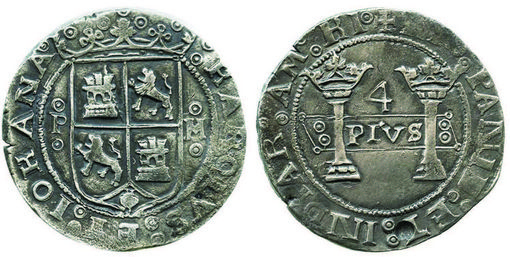 Double rondules-in-annulets on both shield and pillars legend ( Sedwick Treasure Auction #12, lot 895)
Double rondules-in-annulets on both shield and pillars legend ( Sedwick Treasure Auction #12, lot 895)
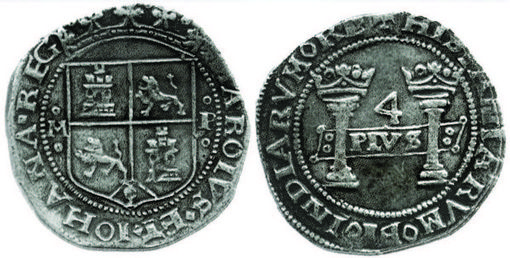 Lozenges in shield legend and mascles in pillars legend (Sedwick Treasure Auction #7, lot 700)
Lozenges in shield legend and mascles in pillars legend (Sedwick Treasure Auction #7, lot 700)
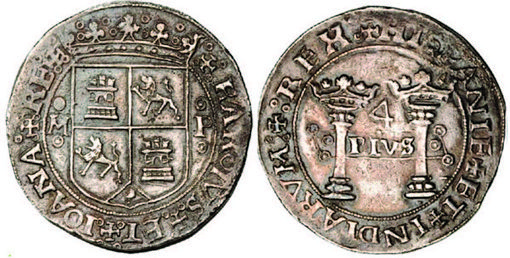 Cross potents with annulets in corners and cross potents in pillars legends and cross potents with annulets in corners in shield legend (Lot 9097, Ponterio Auction #150, August 2009, lot 9097)
Cross potents with annulets in corners and cross potents in pillars legends and cross potents with annulets in corners in shield legend (Lot 9097, Ponterio Auction #150, August 2009, lot 9097)
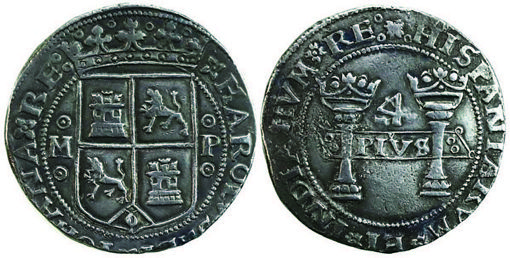 Quatrefoils in both legends (Sedwick Treasure Auction #15, lot 253)
Quatrefoils in both legends (Sedwick Treasure Auction #15, lot 253)
The above examples represent most of the ornaments we find on the coins. I use the same names for these ornaments that Nesmith Nesmith, op. cit., 74. did, namely:
• Rondules-in-annulets and double rondules-in-annulets (solid circle within a larger hollow circle)
• Lozenges
• Mascles (hollowed-out lozenges)
• Cross potents and cross potents with annulets in each corner
• Quatrefoils (of which there are three varieties)
• Annulets (hollow circles)
• Rondules (smaller, solid circles)
To complicate matters, there are two broad time periods of production: coins minted with the legend on the pillars side beginning with HISPANIE followed by those minted with HISPANIARVM. The use of HISPANIE was probably a carryover from coins minted by Assayer P’s predecessor, Francisco del Rincón or Assayer R, who used HISPANIE exclusively. Below are characteristics associated with each There could well be other differences between HISPANIE and HISPANIARVM coins that I have not studied yet. For example, one could study the differences in pillars, shields and shield crowns.:
Characteristics of HISPANIE coins
• Ornaments used for stops in legends are almost always limited to
o Cross potents with annulets in each corner, cross potents, and double rondules-in-annulets on 4-reales coins (exclusively so on the pillars side of the coins)
o Cross potents with annulets in each corner and double rondules-in-annulets on 2-reales coins (exclusively so on the pillars side of the coins)
o Double rondules-in-annulets on 1-real coins (exclusively so on the pillars side of the coins)
• Ornaments within the PLVS banner on the pillars side are limited to
o Single rondule-in-annnulet, double rondules-in-annulets or no ornament on 4-reales coins
o Double rondules-in-annulets on 2-reales coins
o Double rondules-in-annulets or no ornament on 1-real coins
Characteristics of HISPANIARM coins
• HISPANIARVM is found on the legends of Assayer F coins and on all other Charles and Joanna coinage thereafter.
• Assayer and mintmark combination of oMo-oPo on the shield side and a right-leaning banner on the pillars side,in all denominations, is exclusively a HISPANIARVM variety.
• Ornaments used for stops in legends are almost always limited to mascles, quatrefoils, lozenges, and double lozenges in the legends on either side of the coin in all denominations and exclusively so on the pillars side legends. The lozenge in particular was used on both shield and pillars legends. Helping to confirm the theory that these coins were minted after those with HISPANIE is the fact that all F/P and F coins contain lozenges, at least on the pillars side.
• Ornaments within the PLVS banner on the pillars side are limited to
o Single annulet, double rondules, lozenge, or quatrefoil on 4-reales coins
o Single annulet, double rondules, or lozenge on 2-reales coins
o Single annulet on 1-real coins
Additionally, there was a brief transitional period between HISPANIE and HISPANIARVM in which “AR” was punched over the “E” and a cross potent with annulets in the corners (the stop separating HISPANIE and ET). The result was HISPANIARET. This mistake only occurred in the 4-reales coins and only in coins with an oMo-oPo left-leaning panel. I have cataloged only four coins with three different shield-side designs, again confirming that shield designs were at least somewhat independent from pillars designs. It appears that there is only one die for the HISPANIARET coins which also contain a REG/XE error at the end of the legend. The HISPANIE variety from which these coins were altered is known.
Quatrefoils
Quatrefoils can be found on coins from both time periods, but only in the shield side legends. On HISPANIE coins, they are exclusive to the oMo-oPo and left-leaning panel type. Quatrefoils on HISPANIARVM coins can be found on either side of the coin but mostly on the shield side. The following are examples of each of the three types of quatrefoil:
Not only is there great variety with all P coins, there is variety within the rough divisions of the earlier HISPANIE and later HISPANIARVM coins. Below is a table showing the number of varieties I have seen and the number of coins total. I have divided it among HISPANIE and HISPANIARVM:
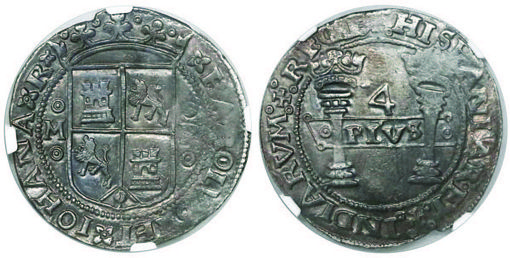 HISPANIARET on pillars side (Sedwick Treasure Auction #21, lot 661)
HISPANIARET on pillars side (Sedwick Treasure Auction #21, lot 661)
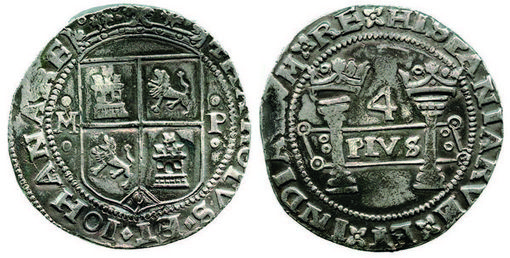 First variety of quatrefoil - four even flower petals – on pillars side (Sedwick Treasure Auction #11, lot 629)
First variety of quatrefoil - four even flower petals – on pillars side (Sedwick Treasure Auction #11, lot 629)
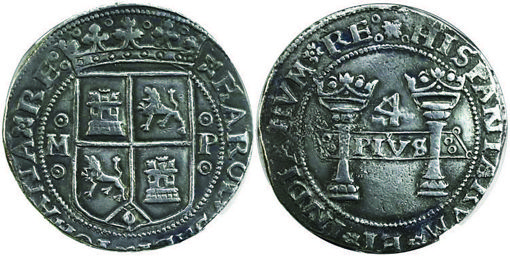
First variety of quatrefoil, on pillars side, and second variety of quatrefoil - eight-petaled flower - on pillars side (Sedwick Treasure Auction #15, lot 253)

Third variety of quatrefoil - four-petaled flower with hollow center - on shield side ( Sedwick Treasure Auction #19, lot 605)
| Number of Varieties and Coin Population for Assayer P Coins | ||||||||
| 4 reales | 2 reales | 1 real | ||||||
| Banner Direction |
Number of Varieties |
Number of Coins Seen |
Number of Varieties |
Number of Coins Seen |
Number of Varieties |
Number of Coins Seen |
||
| P/R | 9 | 26 | 2 | 2 | 1 | 1 | ||
| oPo-oMo | Right | HISPANIE | 2 | 2 | 2 | 7 | 1 | 1 |
| oPo-oMo | Right | HISPANIARVM | 3 | 8 | ||||
| oPo-oMo | Left | HISPANIE | 9 | 18 | 1 | 1 | 1 | 2 |
| oPo-oMo | Left | HISPANIARVM | 2 | 2 | 1 | 1 | ||
| oMo-oPo | Right | HISPANIE | ||||||
| oMo-oPo | Right | HISPANIARVM | 12 | 31 | 17 | 35 | 6 | 9 |
| oMo-oPo | Left | HISPANIE | 13 | 26 | 3 | 5 | 1 | 7 |
| oMo-oPo | Left | HISPANIARET | 3 | 4 | ||||
| oMo-oPo | Left | HISPANIARVM | 32 | 112 | 11 | 26 | 10 | 24 |
| P-M | Right | HISPANIE | 3 | 6 | ||||
| P-M | Left | HISPANIE | 3 | 6 | ||||
There are more questions than answers about the coinage from this time period. For example, we do not know why banners in Early Series coins went from rounded (under Assayer R) to left leaning or right leaning or whether banner direction mattered at all. It is possible that Assayer P banners initially leaned right (as under the last coins minted by Assayer R) then later left, although the assayer-mintmark placement of oMo-oPo and a right-leaning banner is exclusive to HISPANIARVM coins. We also do not know whether assayer-mintmark placement was important. It does not seem to have been, but it became standardized on Late Series coins.
Some conventions were set by the time Assayer P took over from Assayer R:
• Shield design with castles and lions and a crown above
• Pillars design with two tall pillars and no water running underneath them
• All Latin lettering in the legends
• Continuation of standards for coin weight and fineness
• A rhomboid banner leaning either right or left with PLVS inside of it
• An assayer-mintmark placement with one to the left of the shield and one to the right of the shield (not at the bottom of the pillars, as with Assayer R and later with Assayer G under the Early Series)
• Basic legends with KAROLVS ET IOHANA on the shield side and HISPANIE/IARVM ET INDIARVM on the pillars side
• Use of annulets and rondules-in-annulets inside banners and above and below the assayer mark of P and the mintmark of M
Error and Oddball Coins
Most of the spelling and other errors on Assayer P coins occurred on coins of the earlier HISPANIE period, perhaps signaling a trial-and-error approach to coin production.
Occasionally there were errors in spelling, such as the use of a K in place of an H, so IOKANA instead of IOHANA and KISPANIE instead of HISPANIE:
There were also rare spelling errors such as HISPANDIE instead of HISPANIE (see below) and IOMANA instead of IOHANA (on ½-real coins only) See Nesmith, op. cit., #18 coin.:
Rare and interesting are the unusual ornaments found inside the rhomboid banner of HISPANIARVM coins. They consist of lozenges (see below), double lozengesFor an example of the double lozenges error on a 4-reales coin, go to the Banco de México numismatic collection (http://www.banxico.org.mx/ColeccionNumismatica/Consultas?execution=e1s2#) and scroll to inventory #18524, and quatrefoils For an example of the quatrefoil error on a 4-reales coin, go to the American Numismatic Society website (http://www.numismatics.org) and look for coin #2004.6.1 in the MANTIS database.. There are also examples of PLVS split between pillars (P-LV-S) with no ornaments (annulets or rondules-in-annulets) in the corners of the rhomboid banner, only on HISPANIE coins For an example of the P-LV-S error on a 4-reales coin, go to the Banco de México numismatic collection (http://www.banxico.org.mx/ColeccionNumismatica/Consultas?execution=e1s2#) and scroll to inventory #20367:
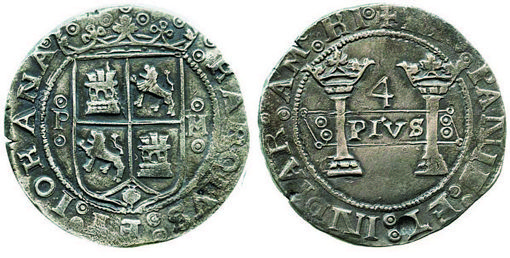 IOKANA on shield side and KISPANIE and KI on pillars side (Sedwick Treasure Auction #12, lot 895)
IOKANA on shield side and KISPANIE and KI on pillars side (Sedwick Treasure Auction #12, lot 895)
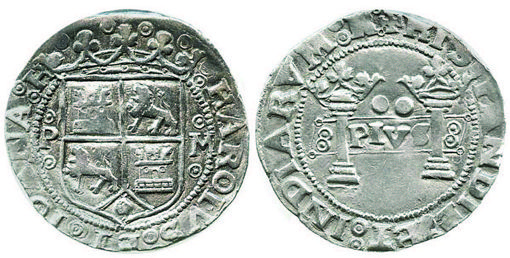 HISPANDIE on pillars side ( Sedwick Treasure Auction #12, lot 898)
HISPANDIE on pillars side ( Sedwick Treasure Auction #12, lot 898)
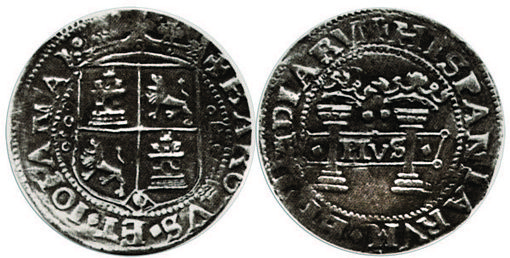 Lozenge within banner on pillars side (Lot 201, Sedwick Treasure Auction #4, lot 201)
Lozenge within banner on pillars side (Lot 201, Sedwick Treasure Auction #4, lot 201)
There are instances of transposed castles and lions on both HISPANIE and HISPANIARVM coins Additional examples can be found in the Banco de México numismatic collection (http://www.banxico.org.mx/ColeccionNumismatica/Consultas?execution=e1s2#) inventory #16687 (1 real) and #20367 (4 reales); Nesmith #19 coin (1 real) and #25b coin (2 reales); and American Numismatic Society website (http://www.numismatics.org), coin #1947.134.35 (2 reales).
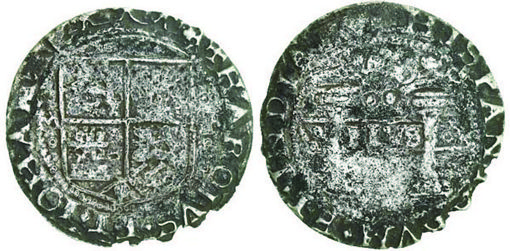 Shipwreck example of transposed castles and lions ( Sedwick Treasure Auction #18, lot 250)
Shipwreck example of transposed castles and lions ( Sedwick Treasure Auction #18, lot 250)
In a period of transition on HISPANIE coins, G was punched over X in REX at the end of the pillars-side legend. Another over-punch (with only one known) occurred when a lion was punched over a castle on the shield. In another type of over-punch the Arabic number 4 was incorrectly placed at a 90-degree angle from upright and a correctly placed 4 was punched over it:
There are several varieties of 1-real HISPANIE coins where there are no annulets or rondules-in-annulets above and below the mintmark M and the assayer mark P See the Banco de México numismatic collection (http://www.banxico.org.mx/ColeccionNumismatica/Consultas?execution=e1s2#) inventory #19 and #20 and Nesmith #19a coin for examples..
Examples of HISPANIE, HISPANIARVM, and Overassayer Coins
Below are examples of Assayer P coins in several denominations under various time periods such as P/R, P in HISPANIE, P in HISPANIARVM, and F/P:
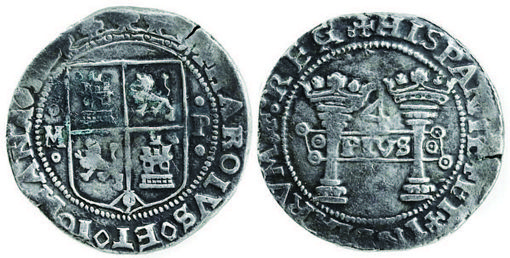 REG/X on pillars side (Sedwick Treasure Auction #15, lot 252)
REG/X on pillars side (Sedwick Treasure Auction #15, lot 252)
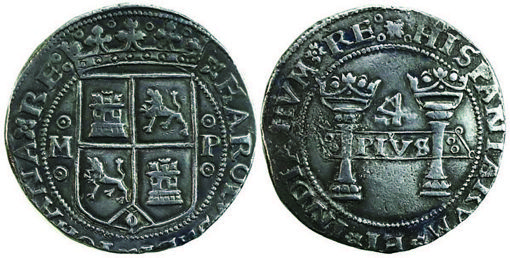 4 punched over 4 on pillars side (Sedwick Treasure Auction #15. Lot 253)
4 punched over 4 on pillars side (Sedwick Treasure Auction #15. Lot 253)
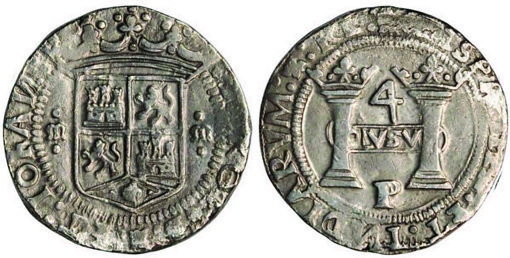
Example of re-used dies of Assayer R for Assayer P 4-reales (Ponterio & Associates Auction #150, lot 9096)
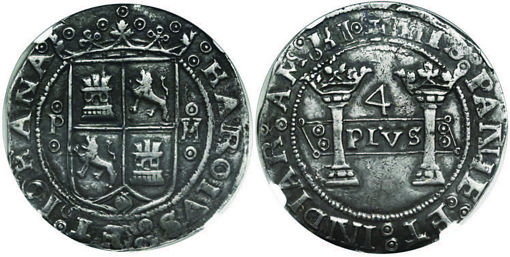 Example of Assayer P 4-reales with HISPANIE in legend (Sedwick Treasure Auction #20. Lot 561)
Example of Assayer P 4-reales with HISPANIE in legend (Sedwick Treasure Auction #20. Lot 561)
Conclusions
Pedro de Espina, the second assayer of the Mexico City mint, was a prolific producer of coins during his tenure of approximately 3½ years. His coins also reflect a high level of skill, as witnessed by the numerous designs and combinations thereof. Whereas the previous assayer, Francisco del Rincón, spent a good part of his time making coins by trial and error (look at the numerous permutations of PLVS VLTRA within the banner on the pillars side of the coins, for example), Assayer P brought a degree of standardization and consistency superior to that of his predecessor. A change in his coins took place when he replaced Assayer R’s use of HISPANIE in the pillars legend to HISPANIARVM, and from this time onward, all coins would read HISPANIARVM. Was this a subtle change in philosophy? At this remove, we cannot be sure whether this was significant or important.
HISPANIE coins tend to be busy with their fussy cross potents with annulets in corners and their rondules-in-annulets everywhere: as stops between words in legends; as ornaments above and below the mintmark and assayer mark; and as ornaments inside the banners and on their corners. On the pillars side legend, these are found exclusively on HISPANIE coins. HISPANIARVM coins, on the other hand, are cleaner, less crowded with unnecessary designs and were probably easier to produce because of that. Quatrefoils, lozenges and mascles were used as ornaments (exclusively so in pillars side legends). In general Assayer P coins mark the beginning of what could be called mass production.
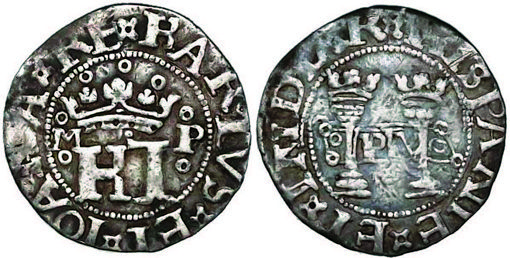 Example of Assayer P ½-real with HISPANIE in legend (Sedwick Treasure Auction #20, lot 576)
Example of Assayer P ½-real with HISPANIE in legend (Sedwick Treasure Auction #20, lot 576)
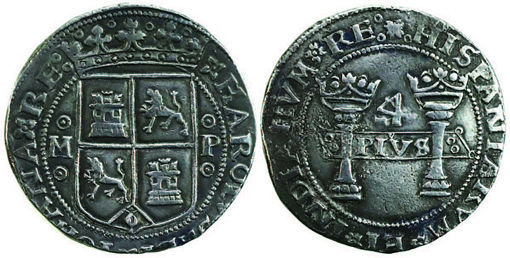 Example of Assayer P 4-reales with HISPANIARVM in legend (Sedwick Treasure Auction #15, lot 253)
Example of Assayer P 4-reales with HISPANIARVM in legend (Sedwick Treasure Auction #15, lot 253)
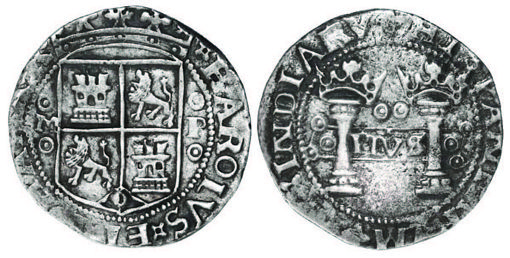 Example of Assayer P 2-reales with HISPANIARVM in legend (Sedwick Treasure Auction #19, lot 605)
Example of Assayer P 2-reales with HISPANIARVM in legend (Sedwick Treasure Auction #19, lot 605)
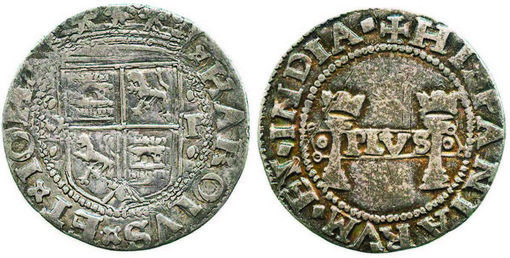 Example of Assayer P 1-real with HISPANIARVM in legend (Sedwick Treasure Auction #12, lot 904)
Example of Assayer P 1-real with HISPANIARVM in legend (Sedwick Treasure Auction #12, lot 904)
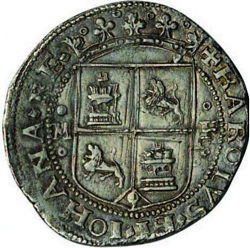
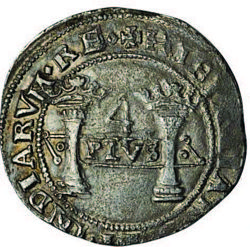
Example of F/P 4-reales (Ponterio & Associates Auction #150, lot 9100)
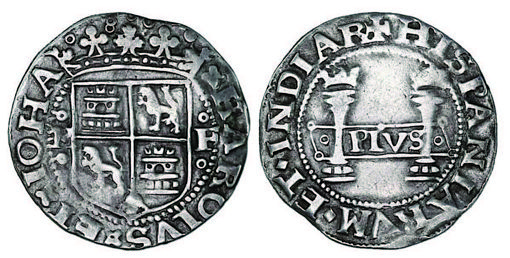 Example of F/P 1-real (Sedwick Treasure Auction #16. Lot 407)
Example of F/P 1-real (Sedwick Treasure Auction #16. Lot 407)
We categorize Assayer P coins much the way Robert Nesmith did, whether the mintmark is to the left and the assayer mark to the right or vice versa, and whether the banner leans to the left or to the right. I also add whether the pillars legend begins with HISPANIE or HISPANIARVM. Nesmith noted this but did not understand its importance since he categorized Assayers F and G before P. There are other elements that could give us more information, such as the varieties of crown designs above the shield, the design of the castles and lions within the shield, and the varieties of crown designs above the pillars. These elements may yield more clues about ordering coins by time period and provide fertile ground for future research. Perhaps future hoards of these coins will also give us more varieties and links to help us with our timeline.
